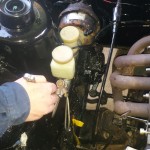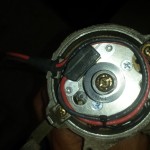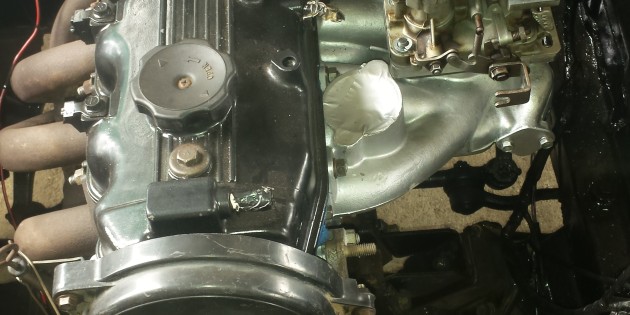We began our suspension works by tackling the front first.
The major issue was the front sway bar. Inspection revealed that the front mount bolt holes were completely stripped in the chassis and the sway bar was freely flapping about. There were no bushes left either which possibly caused vibration, leading to thread wear and finally stripped threads. New urethane bushes, new bolts and steel plates all found their way into the front end to make everything right again.
Whilst the wheels were off, the front wheel bearings were also replaced. Both sides were bad, however the LHS was nearly completely collapsed. A quick check of the struts showed they were serviceable so later down the track they will be stripped to rebuild or replace the inserts.
 Knowing the rear dampers needed replacing and that there was no brake fluid in the rear master cylinder, the rear end was inspected next. The original owner had fitted Sigma rear disc brakes which was a vast improvement on the standard drum brake rear end. Discovering the rear callipers were seized, there were no rear pads left and the hydraulic handbrake cylinder was also shot, soon filled in the blanks as to the missing brake fluid. The master cylinder and rear callipers were rebuilt and found their way into the car with some new braided brake lines, new pads and a new handbrake cylinder. We also found most of the bolts in the rear suspension loose when the well worn Monroe gas rear dampers were removed.
Knowing the rear dampers needed replacing and that there was no brake fluid in the rear master cylinder, the rear end was inspected next. The original owner had fitted Sigma rear disc brakes which was a vast improvement on the standard drum brake rear end. Discovering the rear callipers were seized, there were no rear pads left and the hydraulic handbrake cylinder was also shot, soon filled in the blanks as to the missing brake fluid. The master cylinder and rear callipers were rebuilt and found their way into the car with some new braided brake lines, new pads and a new handbrake cylinder. We also found most of the bolts in the rear suspension loose when the well worn Monroe gas rear dampers were removed.
Whilst in pieces we also found all the leaf spring and shackle bushes were flogged out or non-existent too.
We could hardly believe that the car had competed in some of its latter events with this list of problems and none of the previous owners had known. Worst of all was not the mechanicals. When we dropped the rear wheels, we found the rims were the wrong ones for the car. At some point a set of 80’s Toyota Tarago wheels had been substituted for the correct items. Sure, the stud pattern was right, however the centre bore was far too small and the wheel was sitting on the outer lip of the hub, held in place by just a couple of turns of thread on each wheel nut! The wrongly fitted wheels were also causing the rear discs to flap about instead of seating correctly on the hubs. Another set of wheels became a further line item on the growing list.
During re-assembly the spring bushes were all replaced with urethane units and some heavy duty rear dampers were o rdered to give better road holding at the rear end. Lowering blocks had been fitted by a previous owner and these were re-installed for the time being. In future the rear springs may be lowered and stiffened so that the lowering blocks can be deleted.
rdered to give better road holding at the rear end. Lowering blocks had been fitted by a previous owner and these were re-installed for the time being. In future the rear springs may be lowered and stiffened so that the lowering blocks can be deleted.
Why lowering blocks in a gravel rally car? Well rear wheel drive cars, particularly those with a live axle tend to have serious oversteer (sideways) on loose surfaces. Sure the outrageous drift angles are fun, however not as fast. One trick to reduce the oversteer to a manageable level is to lower the rear of the car slightly in comparison to the front.
After bolting everything back together a new set of front pads were fitted and then it was time to bleed the brakes. We quickly found the front callipers retracted OK however were seized when expanding and so they were rebuilt as well to complete a full brake overhaul.
With a vast improvement in handling and stopping our attention was turned back to the engine bay and ancillaries.
 Onto the distributor. The old points and condenser were thrown out and a performance electronic ignition module and race coil were fitted. These items will give better reliability, better spark and the best part, we’ll never need to replace points. An added bonus is much easier starting too, great for those cold winter mornings for Donnelly, the Experts and Lewana!
Onto the distributor. The old points and condenser were thrown out and a performance electronic ignition module and race coil were fitted. These items will give better reliability, better spark and the best part, we’ll never need to replace points. An added bonus is much easier starting too, great for those cold winter mornings for Donnelly, the Experts and Lewana!
It was a straight forward job to fit the hall sensor kit for the EI. The longest part of the operation was identifying the correct distributor so the manufacturer could send us the right parts to suit. An hour to casually fit the unit including coil is all it took.
With the ignition sorted, induction was next. Electronic Fuel Injection would have been nice, however budget is an issue for many, and an apprentice’s wage will only stretch so far so carburetion would have to do. The car arrived with a set of 45 DCOE side draft Webers on it. With a worked motor, big cam and big valves, the carbs probably would have been ok. We suspected though that the old motor had no compression as the carbs were too big, fuel had been bypassing the rings and washing oil from the bores causing excessive wear.
The Webers too also showed signs of needing a full overhaul (an expensive exercise) so they were sold to fund a more suitable solution. Enter a single carburettor set up.
It was quite a job to remove the complicated Mitsubishi carburettor from the standard L300 manifold. Heat and corrosion had bolts, nuts and studs stuck tight. Despite drowning everything in penetrating oil, we managed to snap a couple of studs near their base. A good dose of heat and some vice grips soon removed each stud once the old carb was separated. The careful work was absolutely essential as the plan was to use a 2L Escort down draft Weber on the standard manifold. The 32/36 Webers have proved themselves a very versatile carb. Over the years they have been fitted as replacement items by many people on many different engines and this was no exception. A used Escort carb was sourced and rebuilt with an overhaul kit. To fit the  Mitsubishi manifold, a Redline adapter kit was used. Sorting the throttle cable required a Toyota Echo throttle plate, a new return spring, a custom fabricated tensioning bracket, and a mountain bike brake cable to actuate it.
Mitsubishi manifold, a Redline adapter kit was used. Sorting the throttle cable required a Toyota Echo throttle plate, a new return spring, a custom fabricated tensioning bracket, and a mountain bike brake cable to actuate it.
Whilst all the work was carried out in the engine bay, the fuel system was also given attention with all new fuel hoses, a new fuel pressure regulator and new filter. Keeping clean air flowing into the engine, a Redline “Biscuit tin” rectangular air filter was fitted. The engine bay was starting to take shape.
The most time consuming section of the whole project was up next- the electrics.





Leave A Response